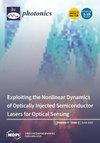382 mW External-Cavity Frequency Doubling 461 nm Laser Based on Quasi-Phase Matching
IF 1.9
4区 物理与天体物理
Q2 OPTICS
引用次数: 0
Abstract
To rapidly improve strontium optical clocks, a high-power, high-efficiency, and high-beam-quality 461 nm laser is required. In blue lasers based on periodically poled KTiOPO4 crystals, the optical absorption in the crystals can induce thermal effects, which must be considered in the design of high-efficiency external-cavity frequency doubling lasers. The interdependence between the absorption and the thermally induced quasi-phase mismatch was taken into account for the solution to the coupled wave equations. By incorporating multilayer crystal approximation, a theoretical model was developed to accurately determine the absorption of the frequency doubling laser. Based on experimental parameters, the temperature gradient in the crystal, the influence of the boundary temperature on the conversion efficiency, and the focal length of the thermal lens were simulated. Theoretical calculations were employed to optimize the parameters of the external-cavity frequency doubling experiment. In the experiment, in a bow-tie external cavity was demonstrated by pumping a 10 mm long periodically poled KTiOPO4 crystal with a 922 nm laser, a 461 nm laser with a maximum output power of 382 mW. The conversion efficiency of the incident fundamental laser was 66.2%. The M2 factor of the frequency doubling beam was approximately 1.4.基于准相位匹配的 382 mW 461 nm 外腔倍频激光器
为了快速改进锶光学时钟,需要一种高功率、高效率和高光束质量的 461 nm 激光器。在基于周期性极化 KTiOPO4 晶体的蓝光激光器中,晶体中的光吸收会诱发热效应,在设计高效率外腔倍频激光器时必须考虑到这一点。在求解耦合波方程时,考虑了吸收与热引起的准相位失配之间的相互依存关系。通过结合多层晶体近似,建立了一个理论模型来精确确定倍频激光器的吸收。根据实验参数,模拟了晶体中的温度梯度、边界温度对转换效率的影响以及热透镜的焦距。理论计算用于优化外腔倍频实验的参数。实验中,通过用 922 nm 激光泵浦一个 10 mm 长的周期性极化 KTiOPO4 晶体,在弓形外腔中演示了最大输出功率为 382 mW 的 461 nm 激光。入射基波激光的转换效率为 66.2%。倍频光束的 M2 因子约为 1.4。
本文章由计算机程序翻译,如有差异,请以英文原文为准。
求助全文
约1分钟内获得全文
求助全文
来源期刊

Photonics
Physics and Astronomy-Instrumentation
CiteScore
2.60
自引率
20.80%
发文量
817
审稿时长
8 weeks
期刊介绍:
Photonics (ISSN 2304-6732) aims at a fast turn around time for peer-reviewing manuscripts and producing accepted articles. The online-only and open access nature of the journal will allow for a speedy and wide circulation of your research as well as review articles. We aim at establishing Photonics as a leading venue for publishing high impact fundamental research but also applications of optics and photonics. The journal particularly welcomes both theoretical (simulation) and experimental research. Our aim is to encourage scientists to publish their experimental and theoretical results in as much detail as possible. There is no restriction on the length of the papers. The full experimental details must be provided so that the results can be reproduced. Electronic files and software regarding the full details of the calculation and experimental procedure, if unable to be published in a normal way, can be deposited as supplementary material.
 求助内容:
求助内容: 应助结果提醒方式:
应助结果提醒方式:


